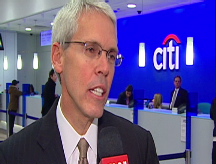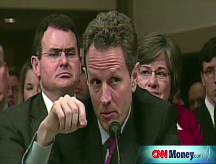Fed bets $800 billion on consumers
Central bank and Treasury announce a massive plan to jumpstart lending.
NEW YORK (CNNMoney.com) -- The Federal Reserve and Treasury Department on Tuesday unveiled a plan to pump $800 billion into the struggling U.S. economy in an attempt to jumpstart lending by banks to consumers and small businesses.
The government hopes that these initiatives will enable more money to flow to consumers in the form of loans than has occurred so far in previous bailout plans.
One program will make $200 billion available from the Federal Reserve Bank of New York to holders of securities backed by consumer debt, such as credit cards, car loans and student loans.
The Treasury Department will allocate $20 billion to back that lending in order to cover any losses that the New York Fed might suffer.
In addition, the Federal Reserve, announced it will purchase up to $500 billion in mortgage backed securities that have been backed by Fannie Mae (FNM, Fortune 500), Freddie Mac (FRE, Fortune 500) and Ginnie Mae, the three government-sponsored mortgage finance firms set up to promote home ownership. It will also buy another $100 billion in direct debt issued by those firms.
Together, the programs from the Federal Reserve and the New York Fed are more than Congress approved in October for a bailout of the nation's banks and Wall Street firms. The Fed said the money will come from an increase in its reserves -- in essence, it is creating new money.
The idea is that by making money available for investors who are interested in buying loans bundled together into securities, it will be easier and more profitable for banks to loan money to consumers and small businesses.
Before the current credit crisis, lenders got the money they needed to extend credit by selling the loans they had already made. But the Treasury Department said the issuance of those securities essentially came to a halt in October.
"This lack of affordable consumer credit undermines consumer spending and, as a result, weakens our economy," said Treasury Secretary Henry Paulson at a press conference.
Still, previous efforts to pump money directly into financial institutions have done relatively little to expand credit available for consumers, and some economists said it was not immediately clear if this money would flow through to households as planned.
"It's certainly not directly going to go through to the consumers. I don't know if anyone can say how much will get through," said Keith Hembre, chief economist at First American Funds. "It certainly shouldn't hurt. We'll have to see how much it does help."
To that end, government officials said that they would not set up the $200 billion consumer lending program until February. So officials couldn't say if the mere announcement of the program would cause lenders to make more credit available to consumers in time for the holiday shopping season.
Paulson described the $200 billion consumer lending program as a first step, one that could be expanded later to include different kinds of debt, including assets backed by commercial real estate mortgages and business debt.
He said the fact that the Fed and Treasury had to work together to get an additional $800 billion into the system is not a sign that the $700 billion bailout of banks and Wall Street firms passed by Congress last month has been a failure. He said that, without that program, it is likely that the financial markets would be in even worse shape than they are today.
"I wish, and I know everybody wishes, that one piece of legislation, and then magically the credit markets would unfreeze," he said. "That's not the type of situation we're dealing with."
The fact that the New York Fed is taking the lead on the consumer lending program means that the man nominated by President-elect Obama to succeed Paulson, New York Fed President Timothy Geithner, played a central role in this new effort.
But Paulson said this is not a sign that the Bush administration is letting the new administration call the shots on further efforts to revive the economy.
How it may affect mortgages
The larger part of the new program is geared toward ending the mortgage crisis, which was the original intent of the bank bailout plan proposed in September and signed into law in October.
That plan, known as the Troubled Asset Relief Program, or TARP, was quickly dropped for one in which Treasury instead made direct capital investments in banks in return for the government receiving preferred shares in the institutions getting funds.
This new program is much closer to the planned bailout. But government officials stressed that this new plan is different from TARP in that only mortgage securities backed by Fannie, Freddie and Ginnie Mae will be in the new program.
The loans being backed by the new program, for the most part, are of better quality than many of the troubled assets that would have been purchased under the original TARP plan.
"This action is being taken to reduce the cost and increase the availability of credit for the purchase of houses, which in turn should support housing markets and foster improved conditions in financial markets more generally," the Fed said in a statement.
There is also limited additional risk for the federal government from the Fed buying that $600 billion in debt from the three firms, since the government is already on the hook for losses those firms suffer on the loans they back.
Despite that implicit government guarantee behind Fannie and Freddie's debt, there gap between rates for U.S. Treasurys and the rates for mortgage assets continues to widen.
But with the Fed buying such a large amount of mortgage assets directly, the hope is that this will narrow that gap and drive down mortgage rates.
The Treasury, which oversees the $700 billion in the TARP program, has been reluctant to expand the use of those funds beyond direct capital investments in banks, despite request to use the funds to help out insurance companies and even the nation's automakers.
The moves came as the Commerce Department announced that gross domestic product, the broadest measure of economic activity, fell at an annual rate of 0.5% in the third quarter.
That was the biggest drop in seven years and economists believe that the economy will decline further in the current quarter and into early next year.
-- with assistance from CNNMoney.com contributing writer Grace Wong in London. ![]()



